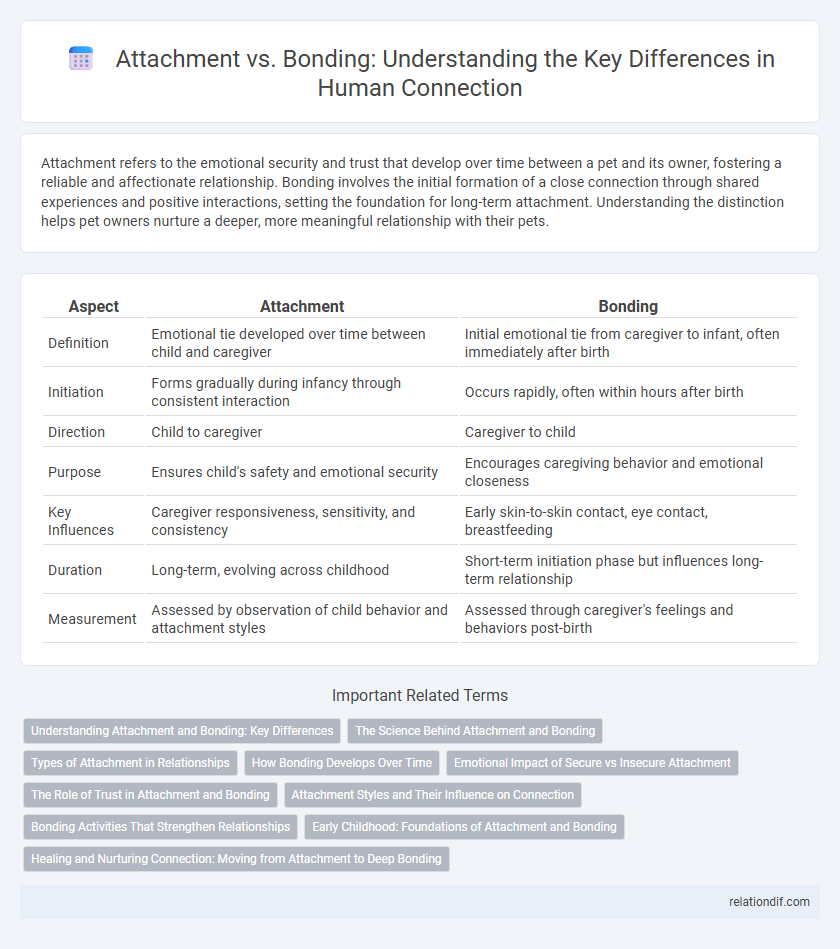Attachment refers to the emotional security and trust that develop over time between a pet and its owner, fostering a reliable and affectionate relationship. Bonding involves the initial formation of a close connection through shared experiences and positive interactions, setting the foundation for long-term attachment. Understanding the distinction helps pet owners nurture a deeper, more meaningful relationship with their pets.
Table of Comparison
| Aspect | Attachment | Bonding |
|---|---|---|
| Definition | Emotional tie developed over time between child and caregiver | Initial emotional tie from caregiver to infant, often immediately after birth |
| Initiation | Forms gradually during infancy through consistent interaction | Occurs rapidly, often within hours after birth |
| Direction | Child to caregiver | Caregiver to child |
| Purpose | Ensures child's safety and emotional security | Encourages caregiving behavior and emotional closeness |
| Key Influences | Caregiver responsiveness, sensitivity, and consistency | Early skin-to-skin contact, eye contact, breastfeeding |
| Duration | Long-term, evolving across childhood | Short-term initiation phase but influences long-term relationship |
| Measurement | Assessed by observation of child behavior and attachment styles | Assessed through caregiver's feelings and behaviors post-birth |
Understanding Attachment and Bonding: Key Differences
Attachment refers to the emotional tie that develops between a child and caregiver, characterized by trust and security essential for healthy psychological growth. Bonding, however, occurs primarily in the early postpartum period, representing the parent's initial feelings of affection and connection toward the infant. Distinguishing these processes helps clarify how long-term emotional development and immediate parental sensitivity impact relational dynamics.
The Science Behind Attachment and Bonding
Attachment and bonding are distinct neurobiological processes critical to human connection. Attachment is characterized by the formation of emotional bonds through repeated interactions, primarily governed by the brain's limbic system and involving hormones such as oxytocin and vasopressin. Bonding, often occurring immediately after birth, initiates this connection via sensory stimuli, triggering neural pathways that establish the foundation for secure attachment and social development.
Types of Attachment in Relationships
Secure attachment in relationships fosters trust and open communication, promoting emotional stability and resilience. Anxious attachment often results in clinginess and fear of abandonment, leading to emotional turbulence and dependency. Avoidant attachment creates emotional distance and difficulty with intimacy, causing challenges in forming close connections.
How Bonding Develops Over Time
Bonding develops gradually through consistent, positive interactions that foster trust and emotional security between individuals. Repeated experiences of care, responsiveness, and mutual understanding strengthen neural pathways associated with attachment and social connection. This process leads to a deep, enduring emotional bond, distinct from initial attachment, which may be more instinctual and immediate.
Emotional Impact of Secure vs Insecure Attachment
Secure attachment fosters emotional resilience, enabling individuals to form trusting relationships and effectively manage stress. Insecure attachment often leads to emotional difficulties, such as anxiety, mistrust, and impaired relationship satisfaction. The quality of early attachment directly influences emotional regulation and social functioning throughout life.
The Role of Trust in Attachment and Bonding
Trust is a foundational element in both attachment and bonding processes, serving as the emotional glue that fosters secure connections. Secure attachment develops when consistent, reliable caregiving builds trust, enabling individuals to feel safe and supported in relationships. In bonding, early experiences of trust with caregivers establish a sense of safety that influences emotional regulation and social development throughout life.
Attachment Styles and Their Influence on Connection
Attachment styles, including secure, anxious, avoidant, and disorganized, significantly shape how individuals form and maintain emotional connections. Secure attachment promotes healthy relationships through trust and open communication, whereas anxious and avoidant styles often lead to challenges like clinginess or emotional distance. Understanding these patterns can improve interpersonal dynamics by fostering empathy and adaptive connection strategies.
Bonding Activities That Strengthen Relationships
Bonding activities such as shared experiences, open communication, and physical affection play a critical role in strengthening interpersonal relationships. Engaging in consistent quality time, practicing empathy, and participating in collaborative tasks enhance emotional intimacy and trust between individuals. These activities foster a secure attachment by reinforcing mutual understanding and emotional connection.
Early Childhood: Foundations of Attachment and Bonding
Attachment in early childhood refers to the emotional tie that develops between a child and caregiver, providing a secure base for exploration and emotional regulation. Bonding focuses on the caregiver's feelings toward the infant, influenced by early interactions such as skin-to-skin contact and responsiveness. Secure attachment established in the first two years supports healthy social, emotional, and cognitive development throughout life.
Healing and Nurturing Connection: Moving from Attachment to Deep Bonding
Healing and nurturing connection involves shifting focus from attachment, often based on dependency and insecurity, to deep bonding characterized by trust and emotional safety. Deep bonding fosters a secure, resilient relationship that promotes healing through consistent empathy, validation, and mutual support. This transition enables individuals to move beyond reactive attachment patterns toward lasting emotional intimacy and well-being.
Attachment vs Bonding Infographic

 relationdif.com
relationdif.com